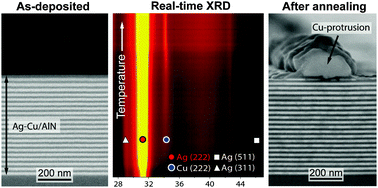Structural evolution of Ag–Cu nano-alloys confined between AlN nano-layers upon fast heating
Abstract
The structural evolution of a Ag–Cu/AlN nano-multilayer (NML), as prepared by magnetron-sputtering on a α-Al2O3 substrate, was monitored during fast heating by real-time in situ XRD analysis (at the synchrotron), as well as by ex situ microstructural analysis using SEM, XPS and in-house XRD. The as-deposited NML is constituted of alternating nano-layers (thickness ≈ 10 nm) of a chemically inert AlN barrier and a eutectic Ag–Cu40at% nano-alloy. The nano-alloy in the as-deposited state is composed of a fcc matrix of Ag nano-grains (≈6 nm), which are supersaturated by Cu, and some smaller embedded Cu rich nano-grains (≈4 nm). Heating up to 265 °C activates segregation of Cu out of the supersaturated Ag nano-grains phase, thus initiating phase separation. At T > 265 °C, the phase-separated Cu metal partially migrates to the top NML surface, thereby relaxing thermally-accumulated compressive stresses in the confined alloy nano-layers and facilitating grain coarsening of (still confined) phase-separated nano-crystallites. Further heating and annealing up to 420 °C results in complete phase separation, forming extended Ag and Cu domains with well-defined coherent Ag/AlN interfaces. The observed outflow of Cu well below the eutectic melting point of the bulk Ag–Cu alloy might provide new pathways for designing low-temperature nano-structured brazing materials.

- This article is part of the themed collection: Recent advances in the chemical physics of nanoalloys

 Please wait while we load your content...
Please wait while we load your content...